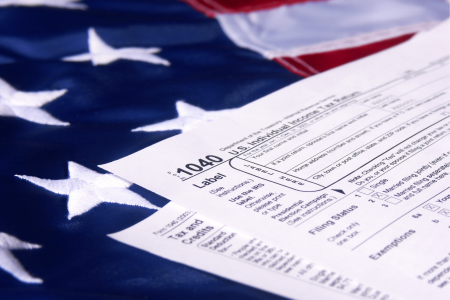In light of tax season, let’s take a look at how the U.S. tax system works.
Because it can be kind of confusing…
FEDERAL INCOME TAX SYSTEM
INDIVIDUALS
For Federal income tax, the U.S. has a progressive tax system. This means when you find out that your tax bracket is at 24%, you aren’t actually paying 24% on all of your income.
Most people think, if you’re single and your taxable income is at $100,000 then you pay $24,000 in taxes ($100,000 x 24%). That’s not the case.
Here is really how it’s calculated:
| (a) Regular Income Tax Rate | (b) Maximum Taxable Income Per This Bracket | (c) Taxable Income | (d) Tax Due [(a) x(c)] |
| 10% | $9,950 | $9,950 | $995 |
| 12% | $30,575 | $30,575 | $3,669 |
| 22% | $45,850 | $45,850 | $10,087 |
| 24% | $78,550 | $13,625 | $3,270 |
| Total | $100,000 | $18,021 |

The tax due is actually $18,021 instead of $24,000. So even though your tax bracket is 24%, you are really paying about 18% in taxes overall.
Which means if you get bumped to the next tax bracket, there’s no need to get too concerned as you will only pay tax on the excess wages in that bracket. In this example even though the taxable income was $100,000 only $13,625 of that $100K is taxed at 24%.
Regular Income Tax Bracket (2021):
| Regular Income Tax Rate | Taxable Income, Single | Taxable Income, Married Filing Separately | Taxable Income, Head of Household | Taxable Income, Married Filing Jointly |
| 10% | $0 to $9,950 | $0 to $9,950 | $0 to $14,200 | $0 to $19,900 |
| 12% | $9,951 to $40,525 | $9,951 to $40,525 | $14,201 to $54,200 | $19,901 to $81,050 |
| 22% | $40,526 to $86,375 | $40,526 to $86,375 | $54,201 to $86,350 | $81,051 to $172,750 |
| 24% | $86,376 to $164,925 | $86,376 to $164,925 | $86,351 to $164,900 | $172,751 to $329,850 |
| 32% | $164,926 to $209,425 | $164,926 to $209,425 | $164,901 to $209,400 | $329,851 to $418,850 |
| 35% | $209,426 to $523,600 | $209,426 to $314,150 | $209,401 to $523,600 | $418,851 to $628,300 |
| 37% | $523,601 or more | $314,151 or more | $523,601 or more | $628,301 or more |
Now keep in mind, these tax brackets are based on your taxable income.
Let’s use our single taxpayer with the $100,000 for taxable income. This single taxpayer would have a higher gross income in order to get to the $100K in taxable income.
For example:
| Gross Income | $112,550 |
| Standard Deduction | ($12,550) |
| TAXABLE INCOME | $100,000 |
You have other adjustments to reduce your gross income. Therefore, you are not paying tax on the full amount of income you received.
On your tax return, you first have to calculate your Adjusted Gross Income, then subtract either the Standard Deduction or Itemized Deductions to reach your Taxable Income.
So, when our single taxpayer received their W-2 stating they made $112,550, then they can have a sigh of relief as they will not be taxed on the full amount.
CORPORATE
Now Corporate Income Tax is a little easier. There is only one tax bracket which is 21% as of 2021.
The only kicker is that Corporations are not taxed on their gross income amount. Just like the individual taxpayer is not taxed on their gross income.
Corporations have deductions that are applicable to their business which are operating expenses.
Here’s how it looks:
| Gross Corporate Income | $1,000,000 |
| Corporate Operating Expenses | ($900,000) |
| NET CORPORATE INCOME | $100,000 |
The Corporation will only pay tax on the net income. In this case, the corporate tax due is $21,000 ($100,000 x 21%).
Some corporate operating expenses are as follows:
- Salaries and wages
- Repairs and maintenance
- Bad debts
- Rents
- Taxes and licenses
- Interest
- Depreciation
- Advertising
- Employee benefit program
- Other deductions
Even though the Corporation brought in a million dollars, the company had to spend $900,000 of those million dollars to keep the business running. This is why the Corporation is only taxed on the net income because that is the only amount the company actually kept as profit.
When looking at a company’s financial statement, you will quickly find out that net profit is what matters, not gross revenue. Because a company can have a great gross revenue but be failing according to their net profit.
PAYROLL TAX
For Federal taxes, you also have payroll taxes to consider. These taxes are also referred to as Social Security/Medicare Tax or FICA.
If you are an employee these taxes are withheld from your paycheck, and if you are self-employed you pay these taxes through “self-employment tax”.
The Social Security tax rate is 12.4%. Your employer will pay half and you pay half. Therefore, you will only see 6.2% withheld from your paycheck.
The Medicare tax rate is 2.9%. Again, your employer pays half of this tax, so your paycheck will show a 1.45% withholding.
If you are self-employed you pay the full 15.3% (Social Security 12.4% plus Medicare 2.9%). Before you get too upset about paying both the employee and employer side of FICA taxes. Self-employed individuals do get to deduct the employer-equivalent portion of your self-employment tax when figuring your adjusted gross income. So, if your self-employment tax amount is $600, you get an above-the-line deduction of $300.
There are other taxes to consider as well like: state and local taxes, sales tax, etc. But hopefully, this gives you a little insight into how our complex tax system works.
Follow along this tax season for more tax tips!
All videos are made with Animaker, sign up for free today!






